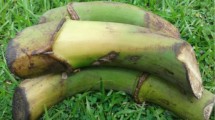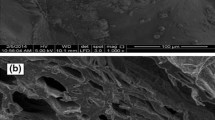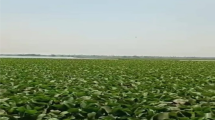Abstract
Adsorption of Remazol Brilliant Blue Reactive (RBBR) dye was investigated using chemically prepared watermelon rind activated carbon (WRAC). WRAC was characterized using BET surface area, FTIR, SEM and proximate analysis techniques respectively. Response surface methodology (RSM) statistical technique was used to optimize the preparation conditions which are activation temperature, activation time and chemical impregnation ratio (IR); with percentage RBBR dye removal and WRAC yield as the targeted responses. Based on the central composite design (CCD), two empirical models were developed and validated by applying ANOVA analysis incorporating interaction effects of three variables using RSM to the two responses. The optimum conditions for preparing WRAC for adsorption of RBBR dye were found as follows: activation temperature of 820 °C, activation time of 2.05 h and IR of 2.85, which resulted in 91.82% of RBBR dye removal and 32.09% of WRAC yield. Experimental results obtained agreed satisfactorily well with the model predictions. WRAC prepared under optimum conditions was mesoporous with BET surface area of 776.65 m2/g, total pore volume of 0.438 cm3/g and average pore diameter of 3.74 nm.



Similar content being viewed by others
References
Adinata D, Daud WMAW, Aroua MK (2007) Preparation and characterization of activated carbon from palm shell by chemical activation with K2CO3. Bioresour Technol 98:145–149
Ahmad AA, Hameed BH (2010) Effect of preparation conditions of activated carbon from bamboo waste for real textile wastewater. J Hazard Mater 173(2010):487–493
Ahmad MA, Ahmad N, Bello OS (2015) Removal of Remazol brilliant blue reactive dye from aqueous solutions using watermelon rinds as adsorbents. J Disp Sci Technol 36:845–858
Alam Z, Muyibi SA, Toramae J (2007) Statistical optimization of adsorption processes for removal of 2,4-dichlorophenol by activated carbon derived from oil palm empty fruit bunches. J Environ Sci 19:674–677
Annadurai G, Juang RS, Lee DJ (2002) Factorial design analysis of adsorption of activated carbon on activated carbon incorporated with calcium alginate. Adv Environ Res 6:191–196
Auta M, Hameed BH (2011) Optimized waste tea activated carbon for adsorption of methylene blue and acid blue 29 dyes using response surface methodology. Chem Eng J 175:233–243
Azargohar R, Dalai AK (2005) Production of activated carbon fromLuscar char: experimental and modeling studies. Micropor Mesopor Mater 85:219–225
Bacaoui, A., Yaacoubi, A., Dahbi, A., Bennouna, C, Luu RPT, Maldonado-Hodar FJ, Rivera-Utrilla J, Moreno-Castilla C (2001) Optimization of conditions for the preparation of activated carbons from olive-waste cakes. Carbon 39:425–432
Bello OS (2013) Adsorptive removal of malachite green with activated carbon prepared from oil palm fruit fibre by KOH Activation and CO2 Gasification. S Afr J Chem 66:32–41
Bello OS, Ahmad MA (2011a) Adsorptive removal of a synthetic textile dye using coca pod husks. Toxicol Environ Chem 93:1298–1308
Bello O.S., Ahmad, M.A. (2011b). Adsorption of dyes from aqueous solution using chemical activated mango peels. 2nd Int Conf Environ Sci Technol (ICEST) 2:108–113
Bello OS, Ahmad MA (2011c) Response surface modelling and optimization of remazol brilliant blue reactive dye removal using periwinkle shell based activated carbon. Sep Sci Technol 46:2367–2379
Bello OS, Ahmad MA (2011d) Removal of remazol brilliant violet–5R dye using periwinkle shell. Chem Ecol 27:481–492
Bello OS, Ahmad MA (2012a) Preparation and characterization of activated carbon derived from rubber seed coat. Chem Bulg J Sci Edu 21:389–395
Bello OS, Ahmad MA (2012b) Coconut (Cocos nucifera) shell based activated carbon for the removal of malachite green dye from aqueous solutions. Sep Sci Technol 47:903–912
Bello OS, Semire B (2012) Equilibrium, kinetic and quantum chemical studies on the adsorption of Congo red using Imperata cylindrica leaf powder activated carbon. Toxicol Environ Chem 94:1114–1124
Bello OS, Adeogun IA, Ajaelu JC (2008) Adsorption of methylene blue onto activated carbon derived from periwinkle shells: kinetics and equilibrium studies. Chem Ecol 24:285–295
Bello OS, Tan TS, Ahmad MA (2012a) Adsorption of remazol brilliant violet-5R reactive dye from aqueous solution by cocoa pod husk-based activated carbon: kinetic, equilibrium and thermodynamic studies. Asia-Pac J Chem Eng 7:378–388
Bello OS, Fatona TA, Falaye FS, Osuolale OM, Njoku VO (2012b) Adsorption of eosin dye from aqueous solution using groundnut hull–based activated carbon: kinetic, equilibrium, and thermodynamic studies. Environ Eng Sci 29:186–194
Bello OS, Ahmad MA, Ahmad N (2012c) Adsorptive features of banana (Musa paradisiaca) stalk-based activated carbon for malachite green dye removal. Chem Ecol 28:153–167
Bello, O.S., Oluwole, O.A. and Njoku, V.O. (2013). Fly Ash: An alternative to powdered activated carbon for the removal of eosin dye from aqueous solutions. Bull Chem Soc Ethiopia 27, 191–204.
Cao Q, Xie KC, Lv YK, Bao WR (2006) Process effects on activated carbon with large specific surface area from corn cob. Bioresour Technol 97:110–115
El Nemr A, Khaled A, Abdelwahab O, El-Sikaily A (2008) Treatment of wastewater containing toxic chromium using new activated carbon developed from date palm seed. J Hazard Mater 152:263–275
El Qada EN, Allen SJ, Walker GM (2008) Influence of preparation conditions on the characteristics of activated carbons produced in laboratory and pilot scale systems. Chem Eng J 142:1–13
Elibol M (2002) Response surface methodological approach for inclusion of perfluorocarbon in actinohordin fermentation medium. Process Biochem 38:660–667
Gratuito MKB, Panyathanmaporn T, Chumnanklang RA, Sirinuntawittaya N, Dutta A (2008) Production of activated carbon fromcoconut shell: optimization using response surface methodology. Bioresour Technol 99:4887–4895
Guo J, Lua AC (2000) Preparation of activated carbons from oil-palm-stone chars by microwave-induced carbon dioxide activation. Carbon 38:1985–1993
Gurusamy A, Ruey-Shin J, Duu-Jong L (2002) Use of cellulose-based wastes for adsorption of dyes from aqueous solutions. J Hazard Mater 92:263–274
Lua AC, Yang T (2004) Effect of activation temperature on the textural and chemical properties of potassium hydroxide activated carbon prepared from pistachio nutshell. J Coll Interf Sci 274:594–601
Myers RH, Montgomery DC (2002) Response surface methodology, 2nd edn. John Wiley and Sons Inc
Namasivayam C, Kanchana N (1993) Removal of Congo red from aqueous solution by waste banana pith. Pertanika J Sci Technol 1:33–42
Sarioglu M, Atay U (2006) Removal of methylene blue by using biosolid. Glob Nest J 8:113–120
Sentorun-Shalaby C, Ucak-Astarlıo˘glu MG, Artok L, Sarıcı C (2006) Preparation and characterization of activated carbons by one-step steam pyrolysis/activation from apricot stones. Micropor Mesopor Mater 88 (2006) 126–134.
Somasekhara-Reddy MC (2006) Removal of direct dye from aqueous solutions with an adsorbent made from tamarind fruit shell, an agricultural solid waste. J Sci Ind Res 65:443–446
Stavropoulos GG, Zabaniotou AA (2005) Production and characterization of activated carbons from olive-seed waste residue. Micropor Mesopor Mater 82:79–85
Sudaryanto Y, Hartono SB, Irawaty W, Hindarso H, Ismadji S (2006) High surface area activated carbon prepared fromcassava peel by chemical activation. Bioresour Technol 97:734–739
Tay JH, Chen XG, Jeyaseelan S, Graham N (2001) Optimizing the preparation of activated carbon from digested sewage sludge and coconut husk. Chemosphere 44:45–51
Wani AA, Kaur D, Ahmed I, Sogi DS (2008) Extraction optimization of watermelon seed protein using response surface methodology. LWT Food Sci Technol 41:1514–1520
Wu FC, Tseng RL (2006) Preparation of highly porous carbon from fir wood by KOH etching and CO2 gasification for adsorption of dyes and phenols from water. J Coll Interf Sci 294:21–30
Zabaniotou, Stavropoulos A, Skoulou G, V (2008) Activated carbon from olive kernels in a two-stage process: industrial improvement. Bioresour Technol 99:320–326
Acknowledgements
The financial support in form of grants from USM under Iconic grant scheme (Grant no. 1001/CKT/870023) for research associated with the Solid Waste Management Cluster, Engineering Campus, Universiti Sains Malaysia, the three months USM-TWAS Visiting Researcher Fellowship, FR number: 3240268492 awarded to the corresponding author and the accumulated leave granted to Dr. O.S Bello by his home institution to utilize the fellowship are thankfully recognized.
Author information
Authors and Affiliations
Corresponding author
Rights and permissions
About this article
Cite this article
Ahmad, M.A., Ahmad, N. & Bello, O.S. Statistical optimization of adsorption process for removal of synthetic dye using watermelon rinds. Model. Earth Syst. Environ. 3, 25 (2017). https://doi.org/10.1007/s40808-017-0269-0
Received:
Accepted:
Published:
DOI: https://doi.org/10.1007/s40808-017-0269-0




